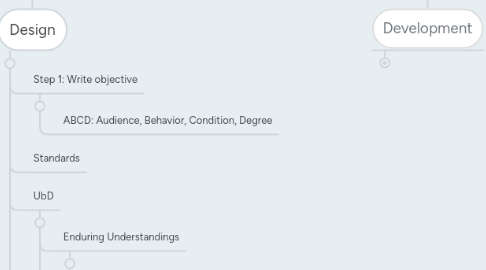
1. Analysis
1.1. Content Analysis
1.1.1. Step 1: What do I know?
1.1.2. Step 2: What are my gaps?
1.1.3. Step 3: Research gaps
1.1.4. Step 4: Fill in research info
1.2. Learner Analysis
1.2.1. Accommodations
1.2.2. ELLs
1.2.3. Assigned grade level
1.2.4. Actual grade level (per subject)
1.2.5. Previous knowledge and skills
1.2.6. strengths and weaknesses
1.2.7. home life/personal issues/feelings
1.2.8. personalities/learning styles
1.2.9. demographics
1.2.10. cultural relevance (e.g. names)
1.2.11. previous academic performance
1.2.12. kids' interest
1.3. Task analysis
2. Design
2.1. Step 1: Write objective
2.1.1. ABCD: Audience, Behavior, Condition, Degree
2.2. Standards
2.3. UbD
2.3.1. Enduring Understandings
2.3.1.1. Concept-verb-concept
2.3.2. Essential Questions
2.3.2.1. how/why + enduring understanding
2.3.3. Supporting Questions
2.4. Unit Map
2.5. Objectives
2.5.1. Step 2: Divide into TO's and EO's
2.5.1.1. Terminal (what you want them to learn at the end) and Enabling Objectives (what you need them to know/learn to get there)
2.5.2. Step 3: Organize and Sequence
2.5.3. Step 4: Thinking about ways of teaching topic
2.6. UdL
2.6.1. I. Provide Multiple Means of Presenation
2.6.1.1. 1. Provide options for perception
2.6.1.2. 2. Provide options for language, mathematical, expressions, and symbols
2.6.1.2.1. 2.1 Clarify vocabulary and symbols
2.6.1.2.2. 2.2 Clarify syntax and structure
2.6.1.2.3. 2.3 Support decoding of text, mathematical notation, and symbols
2.6.1.2.4. 2.4 Promote understanding across language
2.6.1.3. 3. Provide options for comprehension
2.6.1.3.1. 3.1 Activate or supply background knowledge
2.6.1.3.2. 3.2 Highlight patterns, critical features, big ideas, and relationships.
2.6.1.3.3. 3.3 Guide information processing, visualization, and manipulation
2.6.1.3.4. 3.4 Maximize transfer and generalization
2.6.2. II. Provide Multiple Means of Action and Expression
2.6.2.1. 4 Provide options for physical action
2.6.2.1.1. 4.1 Vary the methods for response and navigation
2.6.2.1.2. 4.2 Optimize access the tools and assistive technology
2.6.2.2. 5. Provide options for expression and communication
2.6.2.2.1. 5.1 Use multiple media for communication
2.6.2.2.2. 5.2 Use multiple tools for construction and composition
2.6.2.2.3. 5.3 Build fluencies with graduated levels of support for practice and performance
2.6.3. III. Provide Multiple Means of Engagement
2.6.3.1. 7. Provide options for recruiting interest
2.6.3.1.1. 7.1 Optimize individual choice and autonomy
2.6.3.1.2. 7.2 Optimize relevance, value, and authenticity
2.6.3.1.3. 7.3 Minimize threats and distractions
2.6.3.2. 8. Provide options for sustaining effort and persistence
2.6.3.2.1. 8.1 Heighten salience of goals and objectives
2.6.3.2.2. 8.2 Vary demands and resources to optimize challenge
2.6.3.2.3. 8.3 Foster collaboration and community
2.6.3.2.4. 8.4 Increase mastery-oriented feedback
2.6.3.3. 9. Provide options for self-regulation
2.6.3.3.1. 9.1 Promote expectations and beliefs that optimize motivation
2.6.3.3.2. 9.2 Facilitate personal coping skills and strategies
2.6.3.3.3. 9.3 Develop self-assessment and reflection
2.7. Differentiation
2.7.1. 1. Content
2.7.2. 2. Process
2.7.3. 3. Product
2.7.4. Environment
2.8. Bloom's Taxanomy
3. Development
3.1. Gagne's Events of Instruction
3.1.1. 1. Gain attention
3.1.1.1. Convey information that rouses the learner's interest
3.1.1.2. Use various elements like multimedia,scenarios, and problem statements to attract attention.
3.1.2. 2. Inform learners of objectives
3.1.2.1. Convey what the training teaches
3.1.2.2. List objectives at the beginning of training
3.1.3. 3. Stimulate recall of prior learning
3.1.3.1. Understand the current knowledge level of the target audience
3.1.3.2. Drive learners to relate newly learnt ideas with what they already know
3.1.3.2.1. Use variety of elements to present content, such as flowcharts, diagrams, multimedia, etc.
3.1.4. 4. Present the content
3.1.4.1. 2.5 Illustrate through multiple ideas
3.1.4.2. Convey information that elicits learning
3.1.4.3. (Teacher does it)
3.1.5. 5. Provide guidance
3.1.5.1. Share tips that enable learners to apply the newly taught material
3.1.5.2. Include job aids, cheat sheets, tip boxes, additional references, role plays, etc.
3.1.5.3. (We do it.)
3.1.6. 6. Elicit performance
3.1.6.1. Allow learners to practice the theoretical knowledge they learned
3.1.6.2. Include scenario-based, discussions, role plays, quizzes, etc.
3.1.6.3. (You do it)
3.1.7. 7. Provide feedback
3.1.7.1. Let learners know how they fared during the training
3.1.7.2. Include de-briefing sessions, quizzes, feedbacks, etc.
3.1.8. 8. Assess performance
3.1.8.1. Review learner performance to confirm training was effective.
3.1.8.2. Conduct surveys and post training discussions with supervisors, have on-the-job performance evaluations.
3.1.9. 9. Enhance retention and transfer
3.1.9.1. Provide opportunities to allow learners to recall and apply what they learned during the training.
3.1.9.2. Use social media, newsletter, mailers, blogs, etc.
3.2. Whereto
3.2.1. 1. Where
3.2.2. 2. Hook
3.2.3. 3. Equip & Experience
3.2.4. 4. Rethink
3.2.5. 5. Evaluate
3.2.6. 6. Tailor
4. Implementation
5. Evaluation
5.1. Assessment
5.1.1. Socrative
5.1.2. SMART response
5.1.3. Google forms
5.1.4. Turning points
5.2. Formative Assessment
5.3. Use quality questions
5.3.1. Are you asking information you want to know?
5.3.2. Is it needed to gather new information?
5.3.3. Is it redundant?
5.3.4. opening and dummy questions?
5.3.5. wording-can this question be easily answered?
5.3.6. open-ended: more freedom but greater difficulty
5.3.7. Is it answerable?
5.3.8. Do the words have the same meaning for all groups?
5.3.9. Is it anything vague/ambigiuous?

